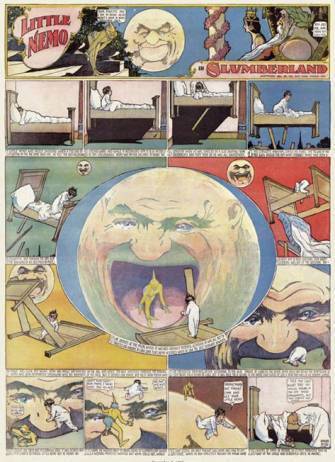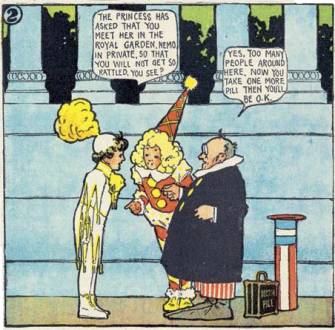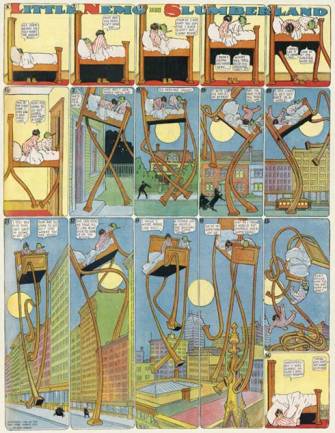 Home > CR Interviews
Home > CR Interviews CR Holiday Interview #4—Kristy Valenti On So Many Splendid Sundays
posted June 19, 2010
CR Holiday Interview #4—Kristy Valenti On So Many Splendid Sundays
posted June 19, 2010

 Kristy Valenti
Kristy Valenti is one of those smart, hard-working and valuable-to-the-cause people you routinely find at the heart of various comics industry operations, in her case
Fantagraphics and
The Comics Journal. In her writing for the
Journal and
in her column at ComiXology, Valenti manifests a curiosity and a sense of discovery perfectly balanced between respect and reverence. I was intrigued when she included
Peter Maresca's high-end
Little Nemo reprints project
So Many Splendid Sundays on her list of potential discussion subjects, and looked forward to asking her questions about it. There's no denying that the ten years just past saw a second golden age of newspaper reprints, and Maresca's efforts have been among the most valuable. -- Tom Spurgeon
*****
TOM SPURGEON: Kristy, can you describe how you ended up at the Journal
in terms of your interest in comics, what you were reading, how you were reading it? If I remember correctly, you were not the typical superhero comics reader; but maybe you weren't an omni-voracious, read-every-genre, read-every-format reader, either. What kind of comics reader were you reading when you began your internship and subsequent employment? How has that changed?
KRISTY VALENTI: I've always been a reader in general and would read whatever was around, including comics, but I working through sections of interest in the Dewey Decimal system when I hit 741.5952. In trades, I read
Barefoot Gen,
Ronin,
Sandman,
Oh My Goddess,
Ranma ½,
Watchmen,
Skin Deep,
The Chuckling Whatsit,
Love and Rockets,
Lewis Trondheim,
Batman: The Killing Joke,
Usagi Yojimbo,
Twisted Sisters,
Animal Man, almost every book in that section they had at the time -- I think our library had such a good collection due to a combination of benign neglect and subversive librarians.
Trina Robbins',
Frederik Schodt's and
D. Aviva Rothschild's books pointed me toward other comics to seek out.
During my internship, I basically got a crash course in comics that I would never have seen in the Direct Market, library or bookstores, by proofreading people who had been writing about comics for longer than I've been alive and spearheading a project to reorganize 30 years' worth of single issues, European albums, minis, magazines, graphic novels, etc. Considering that I didn't know who
Stan Lee,
Steve Ditko or
Jack Kirby were when I started at Fanta/
TCJ, I think it's kind of funny that I put together of most of the superhero writer and artist conversations in
TCJ #300.
In terms of what kind of comics reader I am now: I am a comics reader who perpetually needs to catch up.
 SPURGEON: How much awareness have you had through the years of old-time strips? Has that changed since you've gone to work in comics? Has working at the
SPURGEON: How much awareness have you had through the years of old-time strips? Has that changed since you've gone to work in comics? Has working at the Journal
facilitated your being able to go through these older works?
VALENTI: My friend Chantal's parents had
The Smithsonian Collection of Newspaper Comics as their coffee-table book, so I read that over and over, but that was pretty much it for old-timey strips. After working in the Fanta library, I became exposed to older newspaper-strip collections: for example, Richard Marschall's
The Sunday Funnies, 1896-1950, a box set which reproduces one comic-strip section per decade, is a fantastic sampler, cleverly designed. And by this point, I've worked on almost 50 issues of the
Journal, so I've learned a lot about them from that. Plus, the art department works with comic-strip clippings for books like Popeye, so I've gotten to see lots of those.
SPURGEON: I know that the 1980s generation of comic-strip reprints was a huge factor in my own understanding of comics. Has living through this latest wave of reprints and collections has a significant impact on your own thinking about comics?
VALENTI: I began interning in 2003, so I started working at a big-chain bookstore to support myself. Pretty much simultaneously, we were selling
The Complete Calvin and Hobbes and
The Complete Far Side by the hundreds at work, and they were launching
The Complete Peanuts over at Fantagraphics. It's more like I couldn't have avoided "the golden age of comic-strip reprints" if I had tried.
I have the same little epiphanies when I read a collection of good old comic strips that I think everyone does: these are genuinely funny, the stories are exciting/moving, the art is so skillful/elaborate/I can't get over this penwork, this is so much better than the Saturday morning cartoon/feature film/theme-park mascot... Professionally, they fill in a lot of aesthetic, historical and contextual blanks.
 SPURGEON: How did you initially encounter
SPURGEON: How did you initially encounter So Many Splendid Sundays
? What kind of awareness did you have of Little Nemo
before seeing the book?
VALENTI: I had seen
Little Nemo reprinted, specifically in
The Smithsonian Collection of Newspaper Comics. I knew it was important, historically, but I remember just not being very engaged by it. I don't think I even got to see
So Many Splendid Sundays in the office, or not very much, because we were trying to get it in and then back out to a reviewer. I have to confess that part of my attachment to my personal copy of the book is sentimental: I was dragging my very patient SO to four or five comic shops while we were visiting L.A., and I saw it in Meltdown. As soon as I opened it up I began spazzing out over it, and I showed it to him. So he remembered that, and bought it months later for a present.
SPURGEON: I think the thing that everyone knows about the Peter Maresca project is that the strips have been reprinted at broadsheet size, which makes for this giant book. Certainly McCay was a magnificent artist, but do you think that seeing the work at this size has a significant effect on how this book was received? Does it change the way those strips work or not work as art? Does it connote a validity and important that a smaller book couldn't?
VALENTI: When I saw
Little Nemo at this size, with such rich color work, it simply blew my mind. I got it: it was a revelation, a perfect marriage. I'd
read that McCay was a magnificent artist, but Maresca's project was the first time I was able to actually see it. I could read the words: I could get lost in the drawings. I'm no art expert, but I think
So Many Splendid Sundays does what art does. It doesn't just please the eye: it makes you look at it again and again, think about it, study it from other angles and approach it from different critical perspectives.
So: yes, I think it changes the way the strips work as art; yes, I think the size connotes a validity and importance in this particular instance that a smaller book couldn't; and yes, I think it had a significant effect on how this book was received. I imagine that the this book had appeal for people who like collecting and owning fancy editions, appeal for people who are interested in art for art's sake, and scholarly appeal. I'm sure novelty and nostalgia played a part too.
SPURGEON: Kristy, I have no idea: do you think those comics are great comics? What do you feel are its strengths and weaknesses? Do you agree or disagree with some of the conventional wisdom that extols the obvious craft chops involved but maybe doesn't think much of the stories or scripting? Is there work in So Many Splendid Sundays
that you think is particularly strong, particularly worth noting, a Sunday or a sequence that you thought striking?

VALENTI: I can see how some people might think the scripts and the writing are a weakness, but I don't. I usually come at comics from a story/narrative-first perspective (even if only, "how is the art telling this story?"), because that's my comfort zone and my background, but I think that
Little Nemo resists that. So it can be off-putting and challenging at first. But when I didn't try to read it that way, when I read it in the context of art nouveau design and when I focused on "reading" the images and not the words and what's going on, it began to work for me. I do think these comics are great comics, with the zeal of a convert.
The first strip I think of, of course, when I think of
Little Nemo, is from July 26, 1908, the one where the bed grows long legs and carries Nemo off. I also think the strip where Nemo meets the Princess is flawlessly executed, in art, story and pacing. There are so many strips and panels that just stay with you: the collapse of the mushroom forest; Nemo fretting at the birds on stilts not to kiss him; the Old Year slipping off of the Earth; the Imp, Flip and Nemo getting fat on printer's ink. I think the best punch line in
So Many Splendid Sundays is the one where Slumberland is closed for the week, though.
SPURGEON: Do you think there's anything that McCay specifically offers to modern readers? For instance, I would argue that because of manga's influence comics readers are more amenable to immersive fantasies driven by the art, that we may be more appreciative of or may even read decorative qualities differently than reader would have 20-30 years ago. Is there a new audience for this work?
VALENTI: Sure: if nothing else, it's a good history lesson and can cause a total reevaluation of the comic strip as an art form. Studying McCay for craft is always worthwhile. I'm not sure if I would totally agree with your manga thesis: manga is usually visually, I think, pretty easy to read, and
Little Nemo isn't. Also, I tend to think of
Little Nemo as a pretty "external" strip, and U.S. manga readers tend to emphasize as part of the appeal how subjective it is -- I know the reader is seeing his dreams, so it can be argued that that's subjective, but I feel as if his dreams are presented objectively. I do think contemporary readers process visual information differently from the way people do 20-30 years ago.
This might sound strange but maybe not too far-fetched, since McCay was an animator: in a way, I can almost see
Nemo appealing to anime fans more than manga fans. It would fit right in with a viewing of
Paprika. I also think that
Little Nemo is a perfect example of the Freudian concept of the uncanny, where something is familiar and foreign at the same time, and I think that people are really responding to that in art right now -- although, maybe they never stopped. I mean, David Lynch is more popular than ever.
Getting away from manga, this is also "the golden age of comic-strip reprints," characterized by a burgeoning market, advances in printing technology, the recent legitimization of the comics medium and archival efforts. And I think
So Many Splendid Sundays played a part in that.
 SPURGEON: How do you think people should process characters like Flip or other situations that might not reflect the most enlightened of attitudes in older works like this one? Does that pick at you, bother you personally, or do you kind of accept it as an example of outmoded historical attitudes? Should it have an effect on how we appraise the work?
SPURGEON: How do you think people should process characters like Flip or other situations that might not reflect the most enlightened of attitudes in older works like this one? Does that pick at you, bother you personally, or do you kind of accept it as an example of outmoded historical attitudes? Should it have an effect on how we appraise the work?
VALENTI: Do you mean The Imp?
SPURGEON: [laughs] Yeah, sorry. Of course.
VALENTI: I will give
Noah Berlatsky credit; in
his review for
Little Sammy Sneeze (in
TCJ), he used a method that I thought was pretty fruitful: is this depiction any better or any worse than what was common for the period? McCay's was worse. I don't think these depictions should be erased, I think they should be addressed and put in context. I would like to think that I have enough critical thinking skills to be exposed to things that are racist or sexist or homophobic, especially in a historical context -- I would have a very different attitude if McCay was drawing The Imp like that today, of course -- and recognize that and still be able to evaluate their aesthetic value. So maybe I'm a horrible racist, but I really love the strips with Flip, The Imp and Nemo getting into all sorts of trouble. They're a fun team, they play off of each other well, and The Imp is such a broad caricature, it's hard to associate him with anything even remotely close to any sort of actual human.
 SPURGEON: Do you think
SPURGEON: Do you think So Many Splendid Sundays
is an important book for its publishing particulars? Peter Maresca's story of putting this work out there in this elaborate, risky way and being rewarded for it with such return interest is a really nice one, I think. Do you feel Maresca is indicative of a new breed of comic strip curators, this way of treating the act of collection as an idiosyncratic exercise, or does that factor into how you look at such books at all?
VALENTI: Yes, I do. It is pretty encouraging. I'm glad that Maresca chose to use his fan powers -- obsessive attention to detail, etc. etc. -- for good. And I do think there is some benefit to the blurring of the line between comics and art books.
So Many Splendid Sundays is a pretty textbook example of book as art object.
SPURGEON: Do you think So Many Splendid Sundays
is more of an emblematic work for its own execution or for how it influenced similar projects? What do you think you'll think of when you look back at that work five, ten, fifteen years from now?
VALENTI: I think it's a combination of A and B. I still think it is the best use of the format to date. I hope that when I look at it, hopefully, five, ten, 15 years from now, I continue to discover new facets or bring something different to it that will deepen my understanding of the work.
*****
*
So Many Splendid Sundays, Winsor McCay, Edited By Peter Maresca, Sunday Press Books, hardcover, 120 pages, 9780976888505, 2005.
*****
This year's CR Holiday Interview Series features some of the best writers about comics talking about emblematic -- by which we mean favorite, representative or just plain great -- books from the ten-year period 2000-2009. The writer provides a short list of books, comics or series they believe qualify; I pick one from their list that sounds interesting to me and we talk about it. It's been a long, rough and fascinating decade. Our hope is that this series will entertain from interview to interview but also remind all of us what a remarkable time it has been and continues to be for comics as an art form. We wish you the happiest of holidays no matter how you worship or choose not to. Thank you so much for reading
The Comics Reporter.
*
CR Holiday Interview One: Sean T. Collins On Blankets
*
CR Holiday Interview Two: Frank Santoro On Multiforce
*
CR Holiday Interview Three: Bart Beaty On Persepolis
*****

*****
*****


